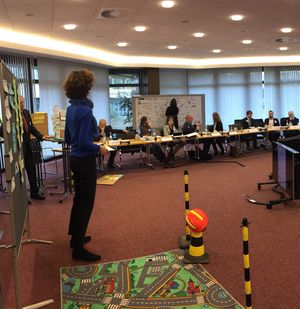KANBrief 2/18

Light influences the human biological clock and a range of physiological processes. In January 2018, a workshop on such non-visual effects of light was organized for the second time by KAN. Numerous stakeholders are involved in the subject; they differ to some extent in their objectives, however. The KAN workshop promotes the exchange of information between all parties involved, and contributes to a strategy being found for future research, standardization and regulation.
Besides permitting vision, both daylight and artificial lighting have non-visual effects upon human beings. One of these effects is to synchronize the human biological clock to the day/night rhythm. In turn, the human biological clock coordinates a range of inner rhythms, such as the sleep/wake rhythm, the time when we are particularly active, and the concentration of hormones and enzymes in our bodies. Light also exerts an effect at each and every workplace. Where daylight is not sufficient, it is supplemented by artificial illumination. In some cases, this has unintended repercussions. Light enriched with a blue component, for example, may have a stimulating effect in the morning and stabilize the human biological clock; in the evening, the same light may knock the body’s rhythm out of step. Lighting systems are now appearing on the market that deliberately trigger non-visual effects by varying the colour temperature of the light (the colour temperature is a measure of the perceived colour of a light source; unit of measurement: Kelvin) according to the time of day. Standards bodies, too, are already very active in this area (NOTE: KAN position paper on the consideration of non-visual effects of lighting in standardization (pdf), September 2022).
Occupational safety and health bodies are under growing pressure to take action in this area. Non-visual effects of light are increasingly coming under the spotlight, and the media are also increasingly addressing the subject. During the construction of new buildings and refurbishing of older properties, consideration is given during planning of lighting to the installation of these new types of lighting system. It is however still unclear how employers and employees should deal with the non-visual effects of light.
Prior to the first KAN workshop, held in Arnsberg in September 2016, the numerous stakeholders such as manufacturers, planners, researchers, employers, employees and also occupational safety and health bodies were working largely in isolation on the subject. The workshop promoted open communication between the parties and broadened their horizons (KANBrief 1/17). In January 2018, KAN brought around 40 experts together for the second time in an interdisciplinary workshop. Since the first workshop, much has happened in the areas discussed by the participants: research activities, such as the study by the Institute for Prevention and Occupational Medicine of the DGUV (IPA) into exposure of nurses to blue light; the KAN literature survey of findings relevant to OSH; the various projects by the German Federal Institute for Occupational Safety and Health (BAuA); and also the awarding of the Nobel prize for medicine for chronobiological research.
In the sphere of regulation, the DGUV Lighting subcommittee is working on a DGUV Informative publication, development of which is already at an advanced stage. In addition to information on the non-visual effects of light, this publication is intended to contain advice for companies. Standards bodies are currently addressing the quantification of non-visual effects of light, particularly at European level. The current state of scientific progress is being compiled by standards bodies at international level.
The participants discussed their possible further course of action and expressed their wishes for the coming years. They called for example for:
Dr. Anna Dammann
dammann@kan.de